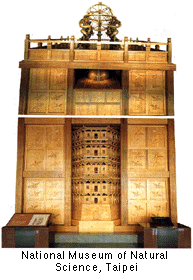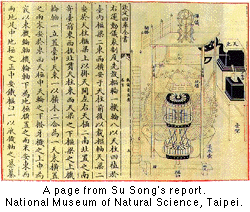The water clock of 1088
 In 1088 Su Song, Minister of Punishments and calendar expert to emperor Chen Tsung, designed and built a clock tower of three levels. It was water driven and consisted of an armillary sphere on the top level, a celestial globe on the middle level and an indication of the time on the lowest level. According to contemporary records it "measured time as exactly as the sundial."
In 1088 Su Song, Minister of Punishments and calendar expert to emperor Chen Tsung, designed and built a clock tower of three levels. It was water driven and consisted of an armillary sphere on the top level, a celestial globe on the middle level and an indication of the time on the lowest level. According to contemporary records it "measured time as exactly as the sundial."
The armillary consisted of 12 rings in three layers. Each ring carried a scale. The position of a planet could be determined by looking through a sighting tube. The celestial globe showed the rise, movement and setting of the stars. Time was indicated by human figurines that struck the hours.
The clock operated in the capital Bianjing (today's Kaifeng in Henan) of the western Sung dynasty for 39 years, when the Jin army took the city. The Jin dismantled the tower and transported it to their capital Yanjing (today's Beijing) but were unable to put it back together. The new emperor then ordered Su Song's son Su Xie to build a replica.
Su Song had written a report to emperor Chen Tsung, Xi Yi Xiang Fa Yao ("New Design for an Armillary Sphere and Celestial Globe"), which contained a complete description and over 60 detailed drawings of his design. But Su Xie found that to keep the design secret, key sections had been removed from the report, so he was unable to obey to the emperor's request.
The original clock tower stood in the open. It was designed to withstand the elements and used bronze castings for all parts that required precision.
 Su Song's water clock was a work of genius. Modern China accepted the challenge to recreate the clock tower twice. A replica in mainland China is of reduced size and did not fully resolve the escapement mechanism. A full-size water-driven replica that keeps accurate time was built in Taichung (Taiwan) in the 1990s and now has pride of place in its National Museum of Natural Science. It uses partly traditional material (bamboo for the water scoops) and partly modern replacement (fibre-reinforced plastic instead of bronze) and an electric pump to carry the water back up to the water reservoir.
Su Song's water clock was a work of genius. Modern China accepted the challenge to recreate the clock tower twice. A replica in mainland China is of reduced size and did not fully resolve the escapement mechanism. A full-size water-driven replica that keeps accurate time was built in Taichung (Taiwan) in the 1990s and now has pride of place in its National Museum of Natural Science. It uses partly traditional material (bamboo for the water scoops) and partly modern replacement (fibre-reinforced plastic instead of bronze) and an electric pump to carry the water back up to the water reservoir.
The most inventive part of Su Song's design was the automatic water drive. 36 tilting scoops were mounted on a large drive wheel. As each scoop filled, at an accurately defined point its weight released a holding lever, allowing the scoop to nod forward. This turned the drive wheel and through a gear system the three levels of the tower. An escapement mechanism of balanced levers prevented the drive wheel from turning past the next scoop. Uniform water flow was achieved through a system of two tanks with overflow, so that the water level (and therefore the water pressure) in the drive tank remained constant as the reservoir emptied.
home
 In 1088 Su Song, Minister of Punishments and calendar expert to emperor Chen Tsung, designed and built a clock tower of three levels. It was water driven and consisted of an armillary sphere on the top level, a celestial globe on the middle level and an indication of the time on the lowest level. According to contemporary records it "measured time as exactly as the sundial."
In 1088 Su Song, Minister of Punishments and calendar expert to emperor Chen Tsung, designed and built a clock tower of three levels. It was water driven and consisted of an armillary sphere on the top level, a celestial globe on the middle level and an indication of the time on the lowest level. According to contemporary records it "measured time as exactly as the sundial." Su Song's water clock was a work of genius. Modern China accepted the challenge to recreate the clock tower twice. A replica in mainland China is of reduced size and did not fully resolve the escapement mechanism. A full-size water-driven replica that keeps accurate time was built in Taichung (Taiwan) in the 1990s and now has pride of place in its National Museum of Natural Science. It uses partly traditional material (bamboo for the water scoops) and partly modern replacement (fibre-reinforced plastic instead of bronze) and an electric pump to carry the water back up to the water reservoir.
Su Song's water clock was a work of genius. Modern China accepted the challenge to recreate the clock tower twice. A replica in mainland China is of reduced size and did not fully resolve the escapement mechanism. A full-size water-driven replica that keeps accurate time was built in Taichung (Taiwan) in the 1990s and now has pride of place in its National Museum of Natural Science. It uses partly traditional material (bamboo for the water scoops) and partly modern replacement (fibre-reinforced plastic instead of bronze) and an electric pump to carry the water back up to the water reservoir.